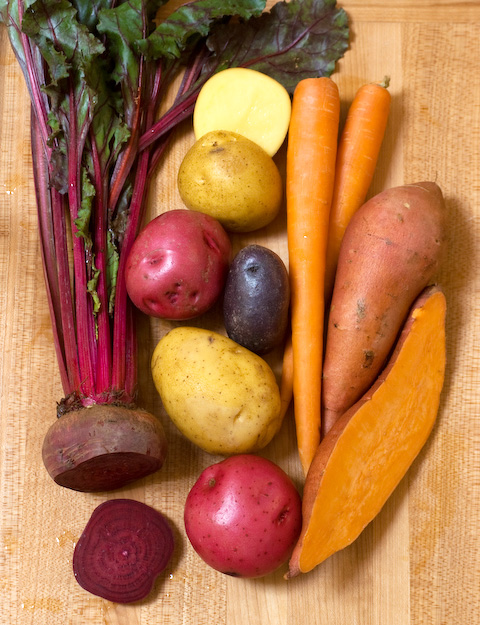Are Carbs Good or Bad?

It depends. The goodness of Nature is displayed in the root vegetables above. The whole grains, dried beans and nuts kept in bins at the health food store look pretty good too. If I wander the center aisles in my grocery store—where the 4 “C’s” of chips, crackers, cookies and candy are found—it gets sketchy. Farm carbs look good, factory carbs not so much. Is it that simple?
One thing to remember about carbs—without them the planet starves. Carbs provide over 60% of energy calories around the world, almost 55% in the U.S. Carbs are the stuff of life. The biggest carb crops are rice, wheat, and corn. To that add legumes and root crops. There’s also a bit in the other vegetables, as well as fruit, and nuts.
Carbs have to be humble. Fats have fancy essential fatty acids like the omega-3s. Eat them or lose your wits. Proteins have essential amino acids critical to growth. But carbs are just a clean-burning fuel that is the best value for energy and nutrients you can find. Which is where the trouble started. Factories thrive on cheap raw materials. The first industrialized products were sugar, polished rice, and refined flours. In each case vital nutrients were removed to provide white, sweet-tasting carbs with a long shelf life. Tasty but unnatural.
These refined carbs introduced a new problem—blood glucose peaks. You’ll remember from the post The Skinny On Being Overweight that surges in blood sugar elevate blood insulin, and insulin packs the sugar away into our cells as fat and keeps it there. So a key to solving the national excess of fat is to reverse the process by leveling the blood glucose level. Real food stabilizes blood glucose and reduces the insulin level, which allows cellular fat to be burned for energy so we can have lean, healthy bodies.
This works pretty well for most people, but not all. We’re all different; some can add weight on a diet that others starve on. In 19th century England there was an obese guy named William Banting who could not lose weight to save his life. Excuse the play on words. Long story short, Banting was introduced to what we call a low-carb diet (no bread, beer, sugar, potatoes, etc. and lots of meat), lost his excess weight, and restored his health. Today the Banting approach to eating is known as the Atkins Diet. The Paleo diet is a variation of this and the French are rediscovering it as the Dukan diet.
The conflict is that the Atkins Diet replaces grains with meat. This is a simplification, as the diet also calls for low glycemic index whole foods of all types. (Glycemic index, G.I., is a measure of how fast the sugar in foods gets into our blood.) Reducing dietary grain in favor of meat is a problem because it runs contrary to food tradition, the Word of Wisdom, and a lot of science. Should a morbidly overweight person who has tried everything else try this? It’s a question to take up with your doctor. Whatever the decision, we wish you well. Stay in touch and let us know how you do.
For most people, replacing factory carbs with farm carbs is the first step towards better health (and should also help with any excess weight). The Healthy Changes are strategic steps towards doing this. Here is some math to keep in mind:
The recent Dietary Guidelines for Americans 2010 recommends that carbs comprise about 55% of our calories. The AHA has recommended that refined sugars not exceed 5% of our calories (on a 2000 calorie diet, 5% of carbs is the recommended 6 tsp.). Therefore, if we get 50% of our calories from whole carbs and limit added sugar to 5% of calories, a healthy but enjoyable diet totaling the recommended 55% carbs is possible.
Here are ten steps that lower G.I. by returning to whole carbs from the farm:
1. Reduce intake of sugary drinks, and candy.
2. Eat a healthy breakfast of whole grains.
3. Replace polished white rice with brown rice or long grain wild rice.
4. Choose whole grain pasta and prepare it al dente to lower the G.I. Avoid tomato sauce with added sugar.
5. Eat 2-3 servings daily of whole grains. See Harvard SPH’s “Health Gains from Whole Grains”.
6. Apply the “whole grain, more fiber than sugar” rule to chips, crackers, cookies and pastries, and use them as special occasion treats.
7. Restore legumes to the daily diet—they’re the best value in food.
8. Choose fruit over fruit juices, or make your own juice from the whole fruit.
9. Eat more nuts and seeds—they’re high in energy but have other benefits.
10. Eat 4-5 daily servings of vegetables.

Planning a weekly menu will simplify your life, improve your health, and save you money. Please share your experiences—the challenges and the benefits—with menu planning. Later this week we will share a weekly menu plan which you can print and use.
Need a reminder? Download our Healthy Change reminder card. Print and fold, then place in your kitchen or on your bathroom mirror to help you remember the Healthy Change of the week.
 Monday, March 28, 2011 at 11:03AM | by
Monday, March 28, 2011 at 11:03AM | by  Skip Hellewell |
Skip Hellewell |  26 Comments |
26 Comments |  8 References | | in
8 References | | in  carbs 101,
carbs 101,  healthy change,
healthy change,  legumes,
legumes,  vegetables,
vegetables,  whole grains |
whole grains |  Email Article
Email Article 
Reader Comments (26)
Catherine, you ask two good questions, ones I have only partially studied. We could rank the nutritional problems by A, B, and C, with A being the most serious. So A would include eliminating trans fats, significant reduction of sugar, and converting refined grains to whole grains, etc. Lacking a complete study, the benefits of sprouting are lower on the list, but desirable. There doesn't seem to be complete agreement that phytic acid is a serious issue. There are problems, but the benefits aren't fully understood. Right now we take a middle road, we don't soak flour for bread, but do soak breakfast grains overnight. What would you add to this?
It does depend on the person; I personally don't feel any different when I use sprouted flour, but I know there are people that do. It does seem that for the most part it is good to reduce phytates, and even then you will probably still get phytic acid for whatever health benefits there may be. I avoid soy, and since sprouted wheat flour is pretty simple to make, I use it in my quick breads (biscuits, muffins, pancakes, etc). I haven't had time yet to experiment with a good sprouted bread recipe, so I do use regular flour for my bread or other yeast breads. I also soak my breakfast grains and almonds, but I prefer my walnuts raw. I haven't tried beans yet, but even when soaked, you don't remove all the phytic acid. So, I guess this is my middle of the road approach: reduce phytic acid for health benefits and you will still get enough phytic acid for its' benefits.
I definitely agree to move away from processed carbohydrates to better sources. However, the question to me is whether grain-based carbohydrates should continue being the majority of the calories.
The latest low-carb approaches and research do not emphasize replacing carbs with meat. (See Phinney and Volek's book (2011) The Art and Science of Low Carbohydrate Living. Actually the paleo/primal diets emphasize the importance of high quality fats. Fats don't have to be all from animal sources either. Macronutrient proportions for carbohydrate sensitive people are in the +60% from fat, not protein. Low carb approaches actually doesn't derive as much as you might think from protein sources. The recommended protein intakes of these diets are much less than the average protein consumption in the standard american diet. What they emphasize is high quality protein sources where the omega-6 to omega-3 ratios are more favorable than grain-fed beef for example - or even better with fish.
The other good idea is to eliminate all processed sugar, focus on berries in terms of fruit, eat plenty of vegetables, and stop fearing fat (especially saturated fat). I wouldn't follow any macronutrient approaches from the government either- especially with regard to carbohydrate intake.
thank you for share this post...look awesome dear
I plan our menu for the whole month and try to keep us at two or fewer meat dishes per week. We're great at eating fruits, and most of our main dinner dishes contain a vegetable or two in them, but we definitely are not getting 4-5 vegetables per day. I know part of my problem is that I'm not usually thinking ahead enough to make a side dish (which would usually be a vegetable) along with the main dish. I'm trying to remedy this a bit next month. But, any other suggestions for how to get in the veggies? Particularly at other meals than dinner?
I loved it!